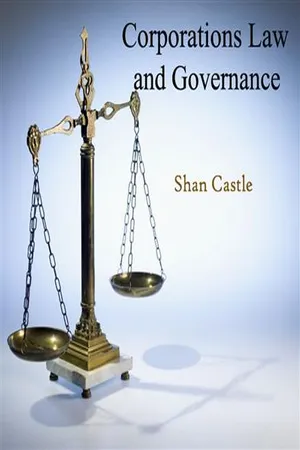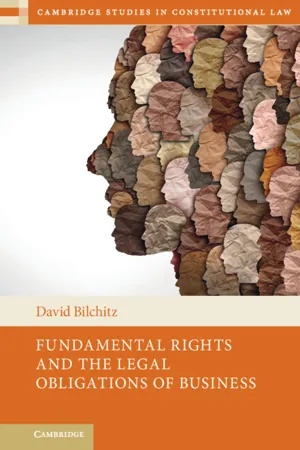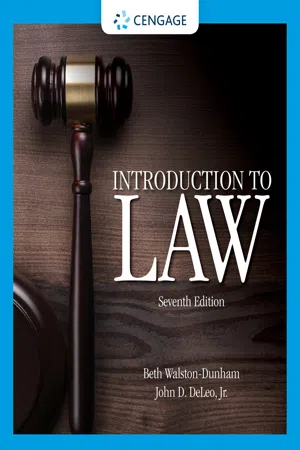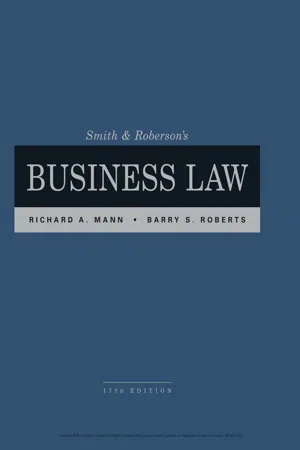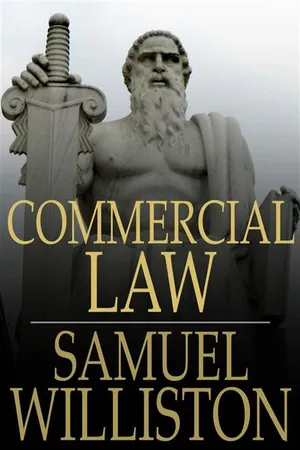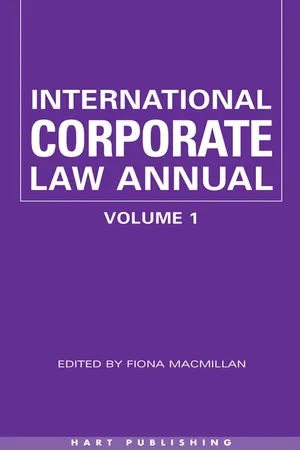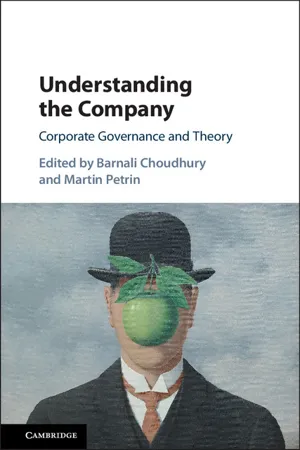Law
Corporations
Corporations are legal entities that are separate from their owners, providing limited liability and allowing for perpetual existence. They can enter into contracts, own property, and sue or be sued. Corporations are formed by filing articles of incorporation with the state and are governed by a board of directors, officers, and shareholders.
Written by Perlego with AI-assistance
Related key terms
1 of 5
11 Key excerpts on "Corporations"
- No longer available |Learn more
- (Author)
- 2014(Publication Date)
- College Publishing House(Publisher)
_____________WORLD TECHNOLOGIES_____________ Chapter- 6 Corporation A corporation is a legal entity that is created under the laws of a state designed to establish the entity as a separate legal entity having its own privileges and liabilities distinct from those of its members. There are many different forms of Corporations, most of which are used to conduct business. Early Corporations were established by charter (i.e. by an ad hoc act passed by a parliament or legislature). Most jurisdictions now allow the creation of new Corporations through registration. An important (but not universal) contemporary feature of a corporation is limited liability. If a corporation fails, shareholders normally only stand to lose their investment and employees will lose their jobs, but neither will be further liable for debts that remain owing to the corporation's creditors. Despite not being natural persons, Corporations are recognized by the law to have rights and responsibilities like natural persons (people). Corporations can exercise human rights against real individuals and the state, and they can themselves be responsible for human rights violations. Corporations are conceptually immortal but they can die when they are dissolved either by statutory operation, order of court, or voluntary action on the part of shareholders. Insolvency may result in a form of corporate 'death', when creditors force the liquidation and dissolution of the corporation under court order, but it most often results in a restructuring of corporate holdings. Corporations can even be convicted of criminal offenses, such as fraud and manslaughter. Although corporate law varies in different jurisdictions, there are four core characteristics of the business corporation: • Legal personality • Limited liability • Transferable shares • Centralized management under a board structure _____________WORLD TECHNOLOGIES_____________ History 1/8 share of the Stora Kopparberg mine, dated June 16, 1288. - No longer available |Learn more
- (Author)
- 2014(Publication Date)
- Orange Apple(Publisher)
Corporate law is about big business, which has separate legal personality, with limited liability or unlimited liability for its members or shareholders, who buy and sell their stocks depending on the performance of the board of directors. It deals with the firms that are incorporated or registered under the corporate or company law of a sovereign state or their subnational states. The four defining characteristics of the modern corporation are: • Separate Legal Personality of the corporation (the right to sue and be sued in its own name i.e. the law treats the company as a human being) • Limited Liability of the shareholders (so that when the company is insolvent, they only owe the money that they subscribed for in shares) • Transferable Shares (usually on a listed exchange, such as the London Stock Exchange, New York Stock Exchange or Euronext in Paris) • Delegated Management, in other words, control of the company placed in the hands of a board of directors In most developed countries excluding the English speaking world, company boards are appointed as representatives of both shareholders and employees to codetermine company strategy. Corporate law is often divided into corporate governance (which concerns the various power relations within a corporation) and corporate finance (which concerns the rules on how capital is used). ____________________ WORLD TECHNOLOGIES ____________________ Corporate law in context Definition The word corporation is generally synonymous with large publicly owned companies. In the United States, a company may or may not be a separate legal entity, and is often used synonymously with firm or business. A corporation may accurately be called a company; however, a company should not necessarily be called a corporation, which has distinct characteristics. According to Black's Law Dictionary, in the U.S. a company means a corporation — or, less commonly, an association, partnership or union — that carries on industrial enterprise. - No longer available |Learn more
- (Author)
- 2014(Publication Date)
- Library Press(Publisher)
____________________ WORLD TECHNOLOGIES ____________________ Chapter- 1 Corporation A corporation is a legal entity that is created under the laws of a state designed to establish the entity as a separate legal entity having its own privileges and liabilities distinct from those of its members. There are many different forms of Corporations, most of which are used to conduct business. Early Corporations were established by charter (i.e. by an ad hoc act passed by a parliament or legislature). Most jurisdictions now allow the creation of new Corporations through registration. An important (but not universal) contemporary feature of a corporation is limited liability. If a corporation fails, shareholders normally only stand to lose their investment and employees will lose their jobs, but neither will be further liable for debts that remain owing to the corporation's creditors. Despite not being natural persons, Corporations are recognized by the law to have rights and responsibilities like natural persons (people). Corporations can exercise human rights against real individuals and the state, and they can themselves be responsible for human rights violations. Corporations are conceptually immortal but they can die when they are dissolved either by statutory operation, order of court, or voluntary action on the part of shareholders. Insolvency may result in a form of corporate 'death', when creditors force the liquidation and dissolution of the corporation under court order, but it most often results in a restructuring of corporate holdings. Corporations can even be convicted of criminal offenses, such as fraud and manslaughter. Although corporate law varies in different jurisdictions, there are four core characteristics of the business corporation: • Legal personality - David Bilchitz(Author)
- 2021(Publication Date)
- Cambridge University Press(Publisher)
1 The Nature and Purpose of the Corporation in Law 1.1 The Dominance of the Corporate Form Business can be conducted in a variety of ways. Its origins, arguably, lie in the simple desire of individuals to trade with one another and, through doing so, to enhance their well-being. These humble origins, however, quickly led to the development of co-operative networks through which people trade. The partnership is perhaps the simplest business form that expresses the desire of individuals to work together for common goals, but it has a number of drawbacks. As a result, over time, the limited liability corporation has emerged as the dominant structure for conduct- ing business. 1 This chapter focuses on attempting to understand, in more detail, the legal nature of the corporation. Two main issues will be addressed in this regard: first, I shall consider the relationship between a corporation and the individuals underlying it; secondly, I shall consider the very purpose of forming a corporate entity. The latter question is often framed in terms of whether a corporation should be conceived of as ‘public’ or ‘private’ in nature. These questions will involve considerations surrounding the function of Corporations in society and their capacity to affect individuals. These reflections on the nature of the corporate form – as will be seen later in this book – are of importance to explicating the obligations such entities have that flow from fundamental rights. 1 Bottomley, 2007: 18–19 outlines the success of the corporate form as well as its significant social impact today. 21 1.2 The Legal Characteristics of the Corporation The corporation has a certain complexity in that it can be formed by one individual acting alone or involve hundreds, if not thousands, of individ- uals in various capacities. To understand this entity, it is useful to start with a short history.- eBook - PDF
- Beth Walston-Dunham(Author)
- 2019(Publication Date)
- Cengage Learning EMEA(Publisher)
Although a cor -poration cannot be imprisoned, it can be fined or dissolved as a penalty for illegal conduct. In addition, the acting individual can be held criminally responsible. LIFE. Generally, the life of a corporation goes on indefinitely as long as the require -ments of the statutes that permitted its creation are met. The statutes that set forth the ways in which a corporation must be created usually establish annual obligations that must be met for the corporation to continue to exist. often these obligations include such things as payment of an annual fee for continued registration with the state as a recognized corporation and annual reports describing the activities of the corporation during the preceding year. LIMITED LIABILITY. Perhaps the greatest advantage of a corporation is that individ -uals who invest in it have limited exposure for losses. ordinarily, a pers on who invests in a corporation is called a shareholder. In return for the investment, a shareholder is given shares of stock in the corporation. The shares represent a percentage of own -ership. The greater the investment, the greater the percentage of ownership. If the corporation does well, the shareholder’s ownership becomes more valuable in terms of the price of the shares or the distribution of profits. If the corporation does badly or a large monetary judgment is rendered against it as the result of a lawsuit, the share -holders usually stand to lose only the amount of their original investment. 39 Thus, the corporation differs from most other types of business entities, in which the owners are responsible for the entire judgment irrespective of whether it exceeds their investment. corporation Entity legally recog -nized as independent of its owners, who are known as shareholders. A corporation can sue or be sued in its own name regarding its own rights and liabilities. Alden and Chloe Jefferson worked for the same clothing store for 30 years. - eBook - PDF
Hedge Fund Activism in Japan
The Limits of Shareholder Primacy
- John Buchanan, Dominic Heesang Chai, Simon Deakin(Authors)
- 2012(Publication Date)
- Cambridge University Press(Publisher)
20 3.1 Introduction Our analysis in this book focuses on companies and the processes by which they are governed. The terms ‘company’ (or in some jurisdic- tions ‘corporation’) and ‘corporate governance’ are, however, ambigu- ous and contested. Our aim in this chapter is to clarify their meaning and to set out how we intend to use them. We first highlight the dis- tinction between two distinct, if intertwined, notions: one is the legal form, the ‘company’, which facilitates and underpins concerted com- mercial activity; the other is the social and economic structure, the ‘business firm’ or ‘business enterprise’, through which production is organised. The term ‘company’ is widely (and to some degree unavoid- ably) used in both senses, but the two meanings are distinct (Robé, 2011). Failure to distinguish between them, or to be clear about which of them is being used in a given context, is a source of confusion in the corporate governance literature, particularly when the role of the law in shaping corporate activity is being described. This observation leads on to our second aim in this chapter which is to specify the nature of the relationship between company (or corpor- ate) law and corporate governance. Company law provides an account of the business enterprise which is in significant respects incomplete. The way that company law describes business firms is not necessarily a good guide to the way that they operate as social or economic organi- sations. Corporate activity and behaviour is shaped, beyond the law, by institutionalised practices of varying degrees of formality. These practices can fill in the gaps left by legal rules and thereby comple- ment their operation, but they can also, on occasion, defeat their pur- pose, or otherwise render them ineffective. The law is just one part of that wider set of routines, norms, and rules which make up ‘corporate governance’ in the context of a given national system or individual enterprise. - eBook - PDF
- Richard Mann, Barry Roberts(Authors)
- 2017(Publication Date)
- Cengage Learning EMEA(Publisher)
Under the modern approach, a corpo-ration may be liable for violating statutes that impose liability without fault. In addition, a corporation may be liable for an offense perpetrated by a high corporate officer or by its board of directors. Punishment of a corporation for crimes is necessarily by fine, not imprisonment. C H A P T E R S U M M A R Y NATURE OF Corporations CORPORATE ATTRIBUTES Legal Entity a corporation is an entity apart from its shareholders, with entirely distinct rights and liabilities Creature of the State a corporation may be formed only by substantial compliance with a State incorporation statute Limited Liability a shareholder’s liability is limited to the amount invested in the business enterprise CHAPTER 33 NATURE, FORMATION, AND POWERS 709 Copyright 2018 Cengage Learning. All Rights Reserved. May not be copied, scanned, or duplicated, in whole or in part. WCN 02-300 - eBook - PDF
- (Author)
- 2013(Publication Date)
- The Floating Press(Publisher)
CITIZENSHIP OF A CORPORATION.—Although a corporation is a separate entity, entirely distinct and apart from its members, such separate entity is not a citizen in the sense in which we use the term ordinarily. At a general election a corporation has no right to vote. Again, Article 4 Section 2, of the United States Constitution, provides that citizens of each State shall be entitled to all of the privileges and immunities of citizens in the several States. A corporation is not a citizen in this sense. Hence a State may keep all insurance companies, incorporated outside of its area, from doing business in that State by discriminating legislation against foreign insurance Corporations. Insurance is not looked upon as interstate commerce, about which the individual States may not legislate, and as a corporation is not a citizen within the meaning of Article 4, Section 2, such insurance companies have no redress. In one sense, however, a corporation is looked upon as a citizen. Where a suit is between citizens of different States, and the amount involved is over the prescribed sum, either party may bring the action in the Federal courts, if he so desires, instead of in the State 156 courts. In this sense, a corporation is to be regarded as if it were a citizen of the State in which it is created. If I live in New York and the American Tobacco Co. is incorporated in New Jersey, suit between us may be brought in the Federal courts on the ground of diversity of citizenship on the part of plaintiff and defendant. POWERS OF Corporations.—A corporation is unable to do anything beyond such powers as are granted it by law. As to the extent of the powers possessed by a corporation, we may conveniently divide corporate powers into those which are express and those which are implied. Express powers may be considered as including those which are mentioned in the official documents used or granted upon the beginning of the existence of the corporation. - eBook - PDF
- Richard Mann, Barry Roberts(Authors)
- 2019(Publication Date)
- Cengage Learning EMEA(Publisher)
Corporate actions include any action taken by or on behalf of the corpora- tion by the incorporator, the board of directors, a com- mittee of the board of directors, an officer or agent of the corporation, or the shareholders. that the incorporators have satisfied all conditions prec- edent to incorporation, except in a proceeding brought by the state. This applies even if the articles of incorporation contain mistakes or omissions. With respect to the attribute of limited liability, the original Model Act (MBCA) and a few states provide that all persons who assume to act as a corporation without authority to do so shall have joint and several unlimited liability for all debts and liabilities incurred or arising as a result of their so acting. The Revised Act, however, imposes liability only on persons who purport to act as or on behalf of a corporation, knowing that there was no incorporation. Consider two illustrations: First, Smith had been shown executed articles of incorporation some months before he invested in the corporation and became an officer and director. He was also told by the corpora- tion’s attorney that the articles had been filed; however, because of confusion in the attorney’s office, they had not in fact been filed. Under the Revised Act and many court decisions, Smith would not be held liable for the obliga- tions of the defective corporation. Second, knowing that no corporation has been formed because no attempt has PRACTICAL ADVICE To obtain limited liability as a shareholder in a corporation, make sure that the corporation has been properly organized before becoming a shareholder. FACTS On February 1, 1988, Robert L. Harris sold his business and its assets to J & R Construction. Joe Alexander, one of three J & R incorporators, signed the contract on behalf of J & R Construction with Harris. - eBook - PDF
- Fiona Macmillan(Author)
- 2000(Publication Date)
- Hart Publishing(Publisher)
1 The Role of the State in Corporate Law Formation GREGORY A. MARK 1 Corporate entities have been the object of concern, hence study, for the greater part of the millennium. Business Corporations have dominated the attention of those concerned with corporate entities for most of the last two centuries of the millennium. 2 As the dominant form of the entity has changed, the mix of methods for addressing the concerns raised by the entity has changed. In the days when the Church was the corporate entity central to society, the natural mode of inquiry was theological, with history enlisted to buttress arguments about the legitimacy of organised hierarchy. 3 During the seventeenth and eigh-teenth centuries corporate entities were primarily political tools, serving the expansionist aims of imperial powers, securing colonies and trade abroad and facilitating consolidation domestically by controlling currency, finance and infrastructure. 4 The nineteenth century saw the corporate entity further evolve, adapting and emphasising the economic ends of corporate existence while nonetheless retaining an essential political component. 5 As adaptations raised political concerns of concentrated and autonomous economic power political arguments were deployed, as had been their theological predecessors, to under-stand and debate the corporation’s place in society. 6 Again, the history of the 1 An early version of this chapter was presented at the 1998 Annual Meeting of the Law and Society Association. I am grateful to Professor Robert Gordon for his comments on the chapter, to members of the panel and audience for comments and questions, and to Amy L Miller for her assis-tance in preparing the chapter. 2 See A F Conard, Corporations in Perspective (Minolta, Foundation Press, 1976), at 135. 3 See A A Berle and G C Means, ‘Corporation’, in The Encyclopædia of the Social Sciences (1931), iv, at 414, 414–5. - eBook - PDF
Understanding the Company
Corporate Governance and Theory
- Barnali Choudhury, Martin Petrin(Authors)
- 2017(Publication Date)
- Cambridge University Press(Publisher)
For instance, on a fundamental level, it is not clear why the Court found that the established separation between the legal entity and individuals should not apply when it comes to corporate rights. More importantly, particu- larly for businesses, it is also unclear from the Court’s reasoning why its holding should not apply to corporate duties as well. On this understand- ing, however, the legal obligations of Corporations could in future cases also be imputed to those who control them, meaning that shareholders (or directors, officers, employees) could become liable for their firm’s debts and other obligations. Given this potential flipside to the Court’s concep- tion of incorporate entities, Hobby Lobby may turn out to be only a pyrrhic victory for businesses and their owners. 10.3.2 Tort and Criminal Law Tort law and criminal law are further areas that reflect the influence of legal entity theories, here in the shape of corporate duties in the form of liability. On the one hand, in Continental Europe, tort law as applied to 38 Hobby Lobby, above n 37 at 2768. 39 Ibid. 40 Ibid. Balancing Corporate Rights and Duties 241 legal entities remains almost wholly captured by the real entity theory. In the case of Corporations, normally, only torts committed by the company’s higher-ranking officials can incur the company’s liability. Although vicari- ous liability for lower-level employees is recognized, establishing the legal entity’s responsibility in several jurisdictions still requires, at least in the- ory, that a higher-level “organ” acting for the entity was negligent in exer- cising her duties in selecting, supervising, or monitoring such employees. 41 The real entity theory’s effects are also visible in Anglo-American law.
Index pages curate the most relevant extracts from our library of academic textbooks. They’ve been created using an in-house natural language model (NLM), each adding context and meaning to key research topics.


